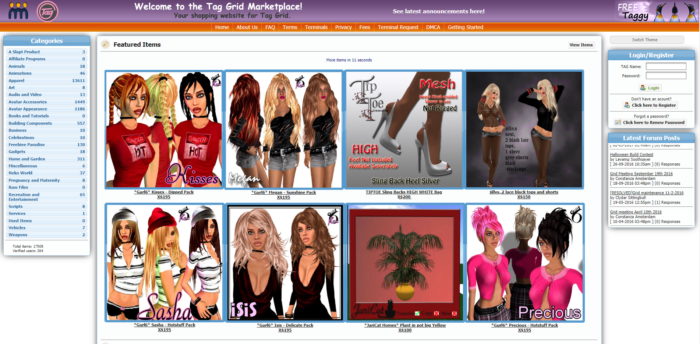
The Tag Grid Marketplace, in development since 2015 but which the grid began widely promoting this year, has grown at nearly twice the rate of the Kitely Market over the past five months.
Tag Grid merchants added 4,058 new item listings, while Kitely merchants added 2,289. However, Kitely is still in the lead with a total of 32,449 different items, compared to Tag’s 21,566.
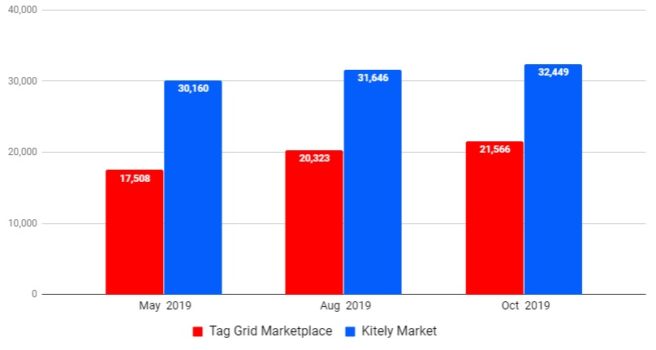
There are two main differences between the marketplaces.
Hypergrid deliveries
First, Tag only delivers products to Tag Grid residents. Tag is a closed grid, so that the content is not allowed to travel to other grids via hypergrid teleport.
By comparison, Kitely is a hypergrid-enabled world, and so is its market. To date, products from the Kitely market have been delivered directly to avatars on 373 different OpenSim grids.
Kitely merchants have the option of keeping their products non-exportable, meaning that they can only be used within the Kitely world and not exported to other grids via hypergrid teleport or other methods, such as OAR region file downloads.
However, 84 percent of the items on the Kitely Market are exportable, meaning that buyers can have them delivered instantly and directly to their avatars on almost any other grid.
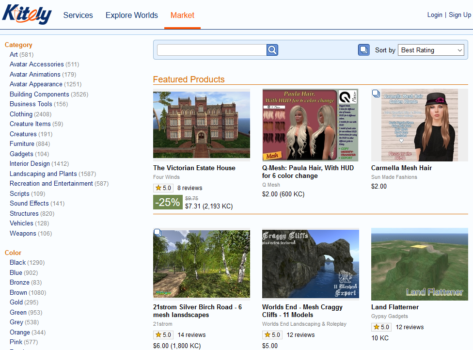
By default, Kitely Market deliveries are available to residents on all hypergrid-enabled grids. However, owners of non-hypergrid grids can also choose to allow residents to shop on the Kitely Market, giving their residents ready access to a wide, legal, and ever-growing collection of content.
As a result, the Kitely Market is preferred by merchants who want to be able to reach the largest possible customer base in OpenSim.
The downside to hypergrid deliveries is that customers can take exportable content to grids or regions that they own themselves, and where they have access to the underlying database or “God powers.” Those customers are then able to reset the permissions of the items. Of course, hackers can easily steal content from any grid, including closed grids. In fact, most stolen content comes from Second Life, the biggest closed grid of them all. The difference is that on the hypergrid, when permissions are changed, the hackers can get access to the underlying scripts. Copybot tools, however, can only steal the appearance of virtual items, not their scripted behaviors.
As a result, merchants with high-end, proprietary scripted content who are worried about theft of their scripts have three options. One is to move their scripts to their own servers, so that very little functionality is included with the item itself. The second is to only distribute their content on closed grids, like Tag, the biggest closed grid in OpenSim. And the third is to distribute their products on a grid that filters content. Several grids, including Kitely, allow content creators to mark their content non-exportable, so that custom scripts, for example, can’t leave the grid.
Open grids have an undeserved reputation for illegal content, since, for the most part, piracy happens on both closed and open grids.
However, Kitely also polices its market carefully to keep illegal content out.
That’s why the growth in listed items hasn’t been as high, Kitely CEO Ilan Tochner told Hypergrid Business.

“There would have been many more had we not been vigilant in removing any reported content that doesn’t follow our TOS, especially as it concerns our policy regarding proper licensing and attribution of third-party content,” he said. “We provide a Report Product link on all Kitely Market product listings and we investigate every such report to ensure that merchants are informed about what they need to do to comply with our requirements and avoid delisting. Kitely works hard to make sure that people will be able to trust the legitimacy of the content that they buy from our marketplace. ”
In addition, merchants that include third-party content in their products must specify it, he said, so that potential buyers can contact the merchant to verify that all the components are also properly licensed.
Counting listings
Tag and Kitely also differ in how they count the number of listings.
Say, for example, you want to buy a great dress like these light pink prom dress styles online. If you were to go to a regular e-commerce site — such as, say, Amazon — you would go to the page with the dress, and then choose the color you want from the variations that the dress comes in.
Kitely does the same. As a result, there are currently only 15,953 product pages on the Kitely Market — but a total of 32,449 variations. And that’s not even counting demos, said Tochner. There are thousands of demos on the Kitely Market, he said.
“This means that if Kitely had used separate product listings for demos then its total number of Second Life-marketplace-like product pages would have been substantially higher than the number of product variations it currently reports,” he said.
Tag, on the other hand, follows the Second Life model, where each variation and each demo of an item is on a separate page.
What sells the best?
This month, Tochner provided an updated list of the best-selling product categories on the Kitely Market for the previous twelve months, based on sales revenue.
The top-selling category, with more than 25 percent of revenues, was landscaping and plants.
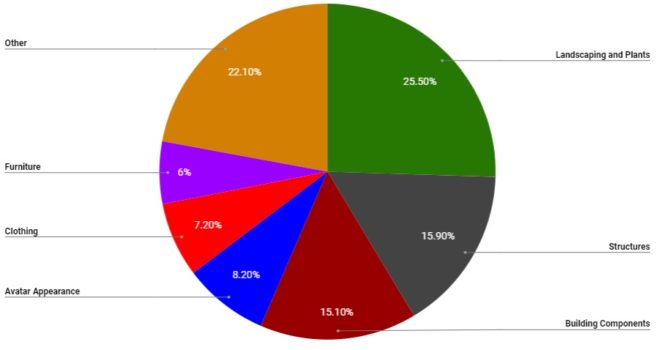
In addition, Kitely Market shoppers can pay via Kitely Credits, or pay with US dollars via PayPal.
According to Tocher, only 14.4 percent of sales revenue was for items paid for with Kitely Credits.
Kitely Credits has been losing ground on the Kitely Market over the past few years. In 2013, Kitely Credits accounted for 41 percent of revenues and dropped to 22 percent in 2015, and to 15 percent in 2016.
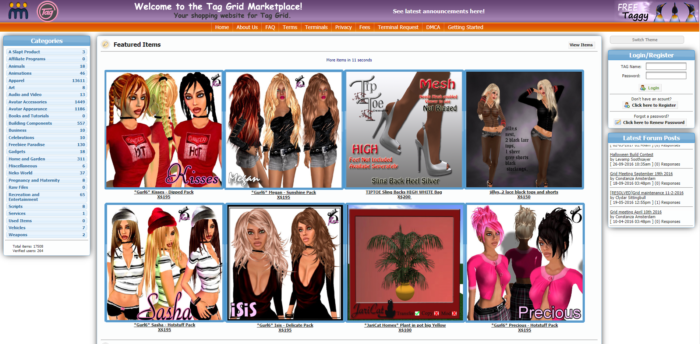
Source: Hypergrid Business
